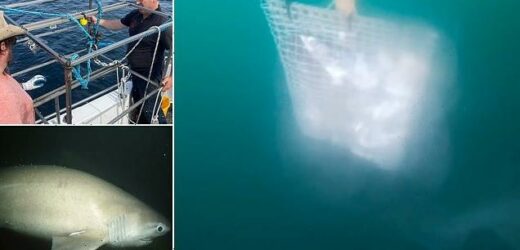Giant sixgill shark is spotted swimming off the coast of IRELAND – marking the first time the prehistoric-looking creature has been filmed in its natural habitat in Europe
- Marine scientists filmed a 13-foot-long sixgill shark off the coast of County Clare
- Sixgill sharks are ‘apex predators’ that can reach 15 feet long and weigh 1,000lbs
- It gets its name from its six gill slits, unlike most other sharks that have only five
Marine biologists have captured footage of a huge sixgill shark swimming off the coast of Ireland – marking the first time it’s been filmed in shallow European waters.
The 13-foot-long ‘prehistoric looking’ sixgill shark (Hexanchus griseus) was discovered off County Clare on the west coast, at a relatively shallow depth of about 200 feet.
An apex predator, the sixgill shark typically inhabits dark waters off the continental shelf, at depths of up to 8,200 feet (2,500 metres).
It spends much of its time miles off-shore off the continental shelf and as a result has little interaction with humans – making this a rare sighting.
The shark gets its name from the fact that is has six gill slits, unlike most other sharks which have only five.
Researchers wouldn’t disclose the exact location where it was filmed – only that it was seen off County Clare
SIXGILL SHARKS
The sixgill shark, sometimes known as the cow shark, is a common species of deep water shark.
They have razor-sharp teeth and resemble fossil sharks from the Triassic period.
Called Hexanchus griseus in Latin, they are also one of the largest sharks that feed on prey other than plankton.
They eat on other fish including sharks, skates and rays, bony fish, squid and crabs.
They have also been known to scavenge on dead animals such as seals.
The sharks live in deep water miles off-shore and as a result this species has little interaction with humans.
There has only been one reported attack on humans in 500 years.
The team of biologists, from Trinity College Dublin, Queen’s University Belfast (QUB) and Belfast-based marine survey company Fjordstrong, filmed the specimen using modified ‘Auto-Release Baited Underwater Video systems’ (ABUVs) – patented fish-identifying video recorders.
The underwater footage shows the shark serenely swimming past the lens in front of a bait bag – a wire mesh full of chopped up and rancid mackerel.
‘This was the first time sixgills have been filmed in shallow water in daylight in European waters, as far as we know,’ Dr Patrick C. Collins, a lecturer in marine biology at QUB and member of the project, told MailOnline.
‘They are normally regarded as a deep-water species.
‘This highlights how Ireland is a biodiversity hotspot for all sharks, skates and rays.’
The experts used the bait bag to attract the shark, although it did not go for it and may have be lured by the lights, Dr Collins said.
‘We observed a lot of smaller fish (wrasse, conger eels, ling and catsharks) feeding on the bait which may also have attracted the shark,’ he said. ‘It circled for a moment and then disappeared.’
Dr Collins said he is not able to disclose the exact location where it was filmed – only that it was seen off of caught off County Clare.
The team is only beginning to answer the mystery as to why sixgills are lurking off County Clare. They will expand their ocean exploration of this area over the next 18 months.
Pictured, the shark swims past the lens in front of a bait bag – a wire mesh full of chopped up rancid mackerel
‘Sixgill sharks are an incredible species and this particular site off the Irish coastline is of particular interest as large, females have regularly been sighted in shallow waters,’ said Haley Dolton, a biologist at Trinity College Dublin.
Sixgills in this location are mostly females, suggesting it is an important area for reproductive purposes, Dolton added.
‘We are going to need a bigger boat to come back here next year and collect more data – we have only just scratched below the surface,’ said Dr Collins.
Sixgill sharks can grow to 15 feet in length and weigh 1,000lbs.
They feed on other fish including sharks, skates and rays, bony fish, squid and crabs. They have also been known to scavenge on dead animals such as seals.
They have razor-sharp teeth and resemble fossil sharks from the Triassic period.
According to the experts, Ireland has the richest diversity in Europe when it comes to elasmobranchii – a sub-class of giant fish.
Basking sharks are found regularly cruising by, and it is also one of the last refugia on earth for the critically endangered flapper skate – the largest skate in the world.
‘It’s like an aquatic Jurassic Park out there,’ said Dr Nick Payne, an assistant professor in Trinity’s School of Natural Sciences.
‘Ireland is the gateway to the Atlantic and we are increasingly amazed at how important Irish waters seem to be for these huge shark and ray species. It means we in Ireland have a responsibility to look after them.
Haley Dolton, a biologist and PhD student at Trinity College Dublin, pictured with a giant fishing net
Sixgill sharks feed on other fish including sharks, skates and rays, bony fish, squid and crabs (stock image)
‘Only by working together with commercial and sports fishers, conservation bodies and government agencies, citizen naturalists and the marine technology industry can we begin to realise and understand our great marine diversity – a heritage of all the people of Ireland.
‘With this knowledge, we are better placed to manage the 90 per cent of our state that currently lie underwater so that future generations can gasp in awe at the giants in our midst.’
Earlier this year, a group of British fishermen caught 14 sixgill sharks in a ‘secret location’ in the north Atlantic dubbed Jurassic Park.
Because of their weight, each shark took an average of 40 minutes to reel in to the Welsh-registered fishing boat.
All of the sharks were returned to the sea safe and well afterwards, but not before the fishermen snapped photos holding them.
THE THREE SPECIES OF SIXGILL SHARK
Sixgill sharks are a group of sharks that have six gills as opposed to the typical five seen in sharks.
There are three species of sixgill sharks, which belong to the genus Hexanchus and are characterised by saw-like lower teeth.
It was originally thought that the genus comprised of just two species: the bluntnose sixgill shark (Hexanchus griseus) and the bigeye sixgill (Hexanchus nakamurai).
They are distributed worldwide in tropical and temperate waters.
According to a study led by Toby Daly-Engel, a researcher at the Florida Institute of Technology, many verified records for these species are lacking, and misidentification is common.
A newly identified species of sixgill shark, the Atlantic sixgill shark (Hexanchus vitulus), settled the debate as to whether bigeye sixgill sharks from the Atlantic constitute a separate species in February 2018.
The three species can be described as follows:
Bluntnose sixgill shark (Hexanchus griseus): This large, deepwater shark has comb-like, yellow lower teeth, a long tail, and is the largest of the sixgill species, with an average length of 15 to 16 feet (4.6 to 4.9 metres).
It has a blunt, rounded snout, and a single dorsal fin. Its skin colour is dark, ranging from greyish brown to black on the back, and fading lighter towards the belly.
Its eyes are bright green and it feeds nocturnally, ambushing its prey. Because it lives in deep waters, not much is know about it.
Bigeye sixgill shark (Hexanchus nakamurai): A little-known, moderately large shark up to 5.9 feet (1.8 metres) long. I
t is slender and has a small dorsal fin far along its back, and large reflective green eyes. It is usually dark to light grey on top, fading to white underneath.
Atlantic sixgill shark (Hexanchus vitulus): Measures up to six feet (1.8 metres) long and lives at extreme ocean depths.
It is currently thought to be restricted to the Atlantic and looks very similar to the bigeye sixgill shark.
Source: Read Full Article






